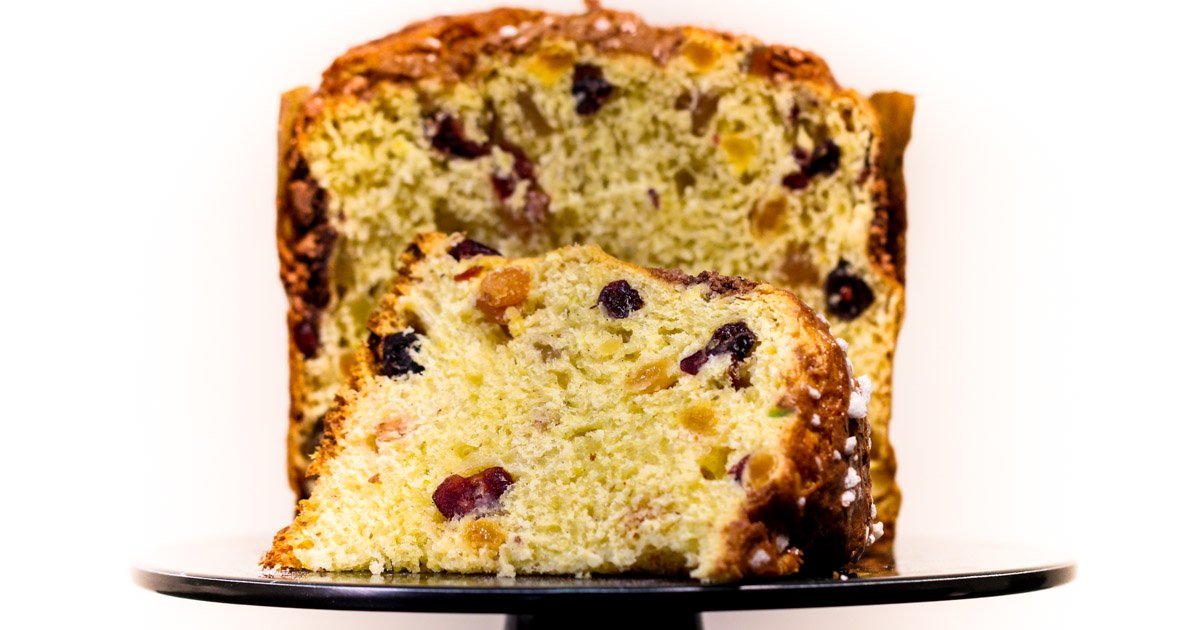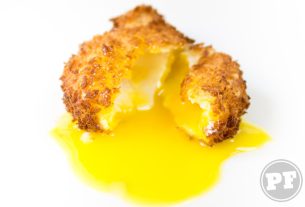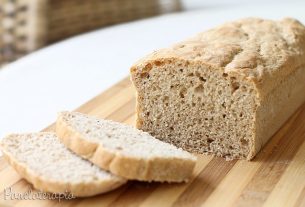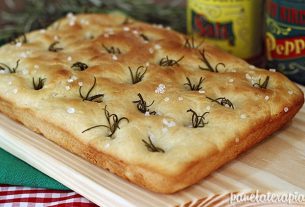For the end of the year festivities, I wanted a new challenge. Try to make our traditional Panetone as it was once done with wild yeast (but insist they call it natural yeast). Is it worth it?
As I no longer maintain any active wild natural yeast culture at home, I had to start creating a new one! If you want to learn how to make your own:
But what is the challenge of making panettone like that? Well… just for the panettone itself, it took 48 hours. Not counting the 7 days to create the baking powder.
Adaptation of Natural Inseration
However, before someone swears to me: I know that, usually (for what I can search) for panettone is used the mother Lievito which is a type of yeast created as well.
The difference is to be thickerespesso, it is firmer: they call it a stiff in English. While, the sourdough (or levain) we always see is more liquid and soft. And in my case, it is a 100% hydration yeast.
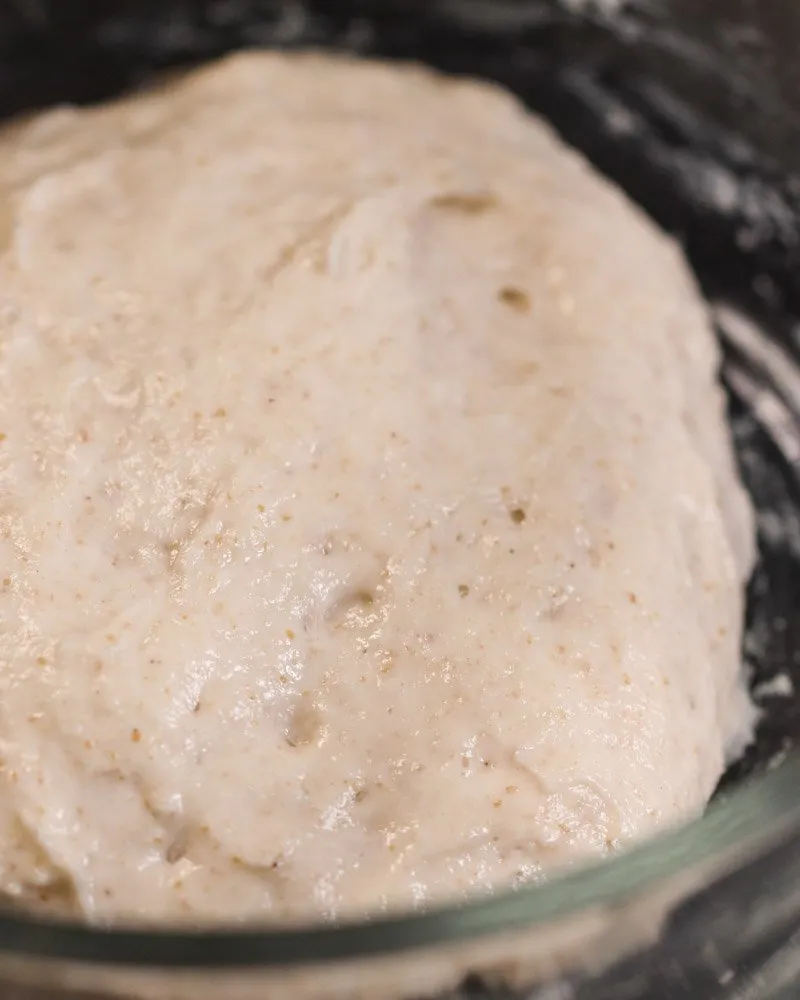
I even looked at recipes of how Lievito was made, but the time was always longer than the yeast I already know how to do. Was all lost? No! No! It is possible to adapt a ferment created sourdough style to be used in the panettone.
To get to my panettone recipe, I used as the basis that Joshua Weissman posted in 2019, and in the video he also taught how to make this adaptation.
Adaptation or maintenance consists of feeding between 3-4 times the yeast every 4 hours. For my recipe-experiment, I fed 3 times before leaving for the recipe itself.
Flour of Enriched Wheat
As you read the recipe you will see that I have put a ingredientedifferent ingredient: Enriched Wheat Flour. It’s my personalized blend of wheat flour.
Virtually all panettone gringa recipes use flour for bread or strong flour that they call bread flour or strong white flour, respectively. What do they have in common? The total protein content is around 12-14%.
To achieve something similar to this I added more gluten in the common flour that has around 10% total protein. You can buy gluten flour at health food stores.
But you need to pay attention to this gluten flour. I have seen two versions sold: 40% and 75% gluten. For the recipe, I used the 75% version. The information is usually written on the packaging.
My final mixture was 13 percent of total protein. To make the correct calculation, you have to use the Gauss Elimination or the Flour Math calculator that does this automatically.
The texture… the texture!
I’ve been since mid-June, July testing versions of panetones. I mean, wheat flour. From different brands and the like to achieve the texture of the panettone in a homemade kitchen and without the facilities that the industry has. Oh yes: it was another simpler recipe, but still.
Despite the good taste, the texture… the texture! I only got the texture I wanted when I used gluten. Until I tested the flour improver, the sweet bread was good, but it was not panettone.
Be it: panettone is a kind of sweet bread, but not all sweet bread is a panetone, do you see the difference?
And stops to analyze the recipe of panettone makes sense. Panettone, as I said, is a sweet bread that is called enriched bread. After all, there are many other ingredients that ordinary bread does not use.
It has addition of eggs (gemas), fat (cleated), more sugar and the filling in itself. In this case, the crystallized fruits. All this requires a mass with a stronger structure that sustains all these additional ones.
The responsible for this is gluten, the protein weft created when we mix water and agitation makes all the difference.
Of course, keep in mind that my vision of an ideal panettone may be quite different from yours, so take that into consideration.
Planning of the Panetone
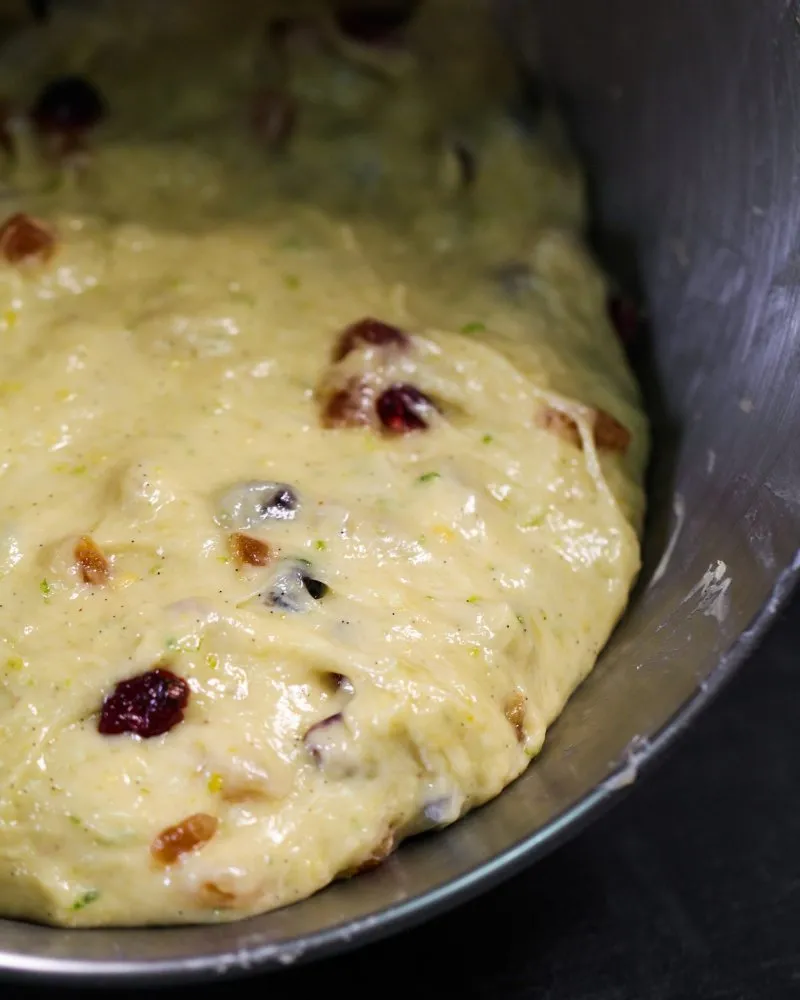
If you are going to make the recipe (which I doubt very much that someone will do, hahahah): program well.
My schedule was as follows:
- Thursday 09 hours : first adaptation of the yeast
- Thursday 13 hours : second adaptation of the yeast
- Thursday 17 hours : third adaptation of yeast
- Thursday 21 hours : ready adapted yeast and base dough
- Friday 09 hours: base mass fermented 12 hours and the beginning of the final mass
- Friday 10 hours : 1 hour fermentation and bending technique
- Friday 11 hours : separation of mass in the portions
- Friday 12 hours : last fermentation of 6-8 hours
- Friday 20 hours : roast the panetones
- Friday 21 hours : leave upside down and cool
- Saturday 09 hours : Cold and cut panetones
It was 48 hours between starting out you can eat, but reading the recipe you will see that you have a lot of time waiting to ferment. It’s all about controlling the weather and temperature.
And, yes. It was 12 hours of fermentation of pasta base and then another 9 hours with the final pasta. And yes, it was hot on the day, about 30-32oC.
Did it feel good?
That’s the big question, isn’t it?
Yeah, it was amazing. The best homemade style that I’ve ever made and ate! That said. I wouldn’t do it again: too long, help. Who has the time and patience for it?
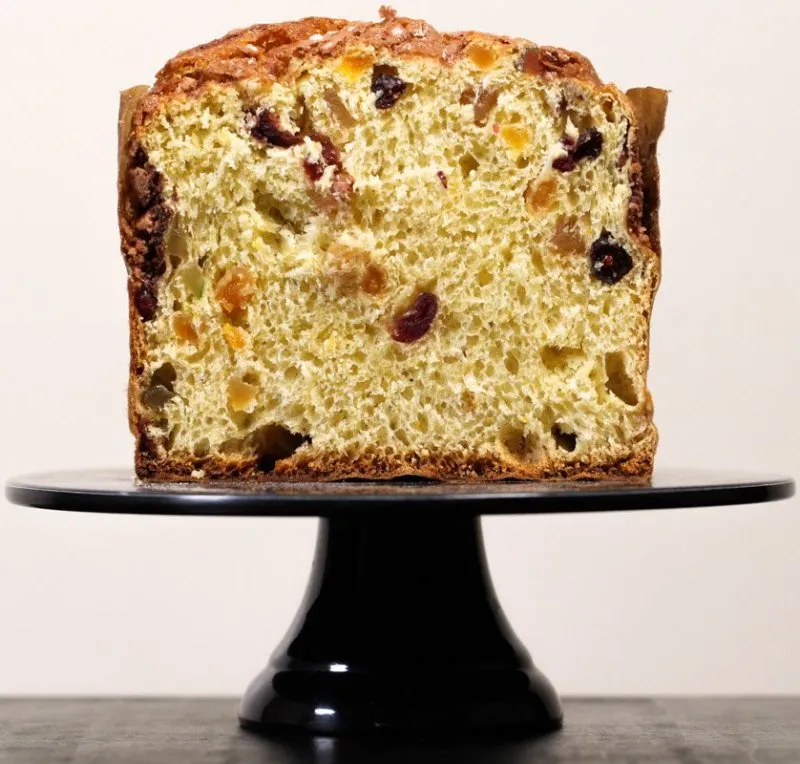
Let’s face it in people: there’s no way it got bad, bad. In the panettone there is a good amount of yolks, butter, vanilla and favorite candied fruits. In the worst case, you have at the end a delicious sweet bread.
In the recipe has a crunchy coverage of sugar and cocoa that reminds us (here in Brazil), that house of the pascal colomba. I put it on only one, but I recommend (if anyone via doing hahahah) that he puts on everyone.
There is no way to realize that the ferment created was used, excuse there (or not) who will slap his foot saying that he gives. In this recipe, there is no way to know for several reasons.
- The adaptation made in the beginning, incredible as it may seem, are short periods of adaptation of the culture. The microorganisms present do not have enough time to produce the substances that could impact the aroma/flavor. And, panettone is not sour, so that makes a lot of sense.
- It is an enriched mass: the addition of so many ingredients affect the growth of the crop. Fat and sugar modulate the pace of growth and those who can stay alive in the mass.
- It has strong aromatic ingredients with strong taste. The scrapings of citrus and the sweet taste of the crystallized fruits are much more pungent in this regard.
- Learn more about fermentation.
I would give you the same panettone with the organic yeast (fresh or dry), the only detail that would have to change: the amount of yeast. Put less time to have more time to develop gluten passively and have a longer fermentation.
Another interesting point of the mass (I believe you can see in the photos), I thought that the panetones were a little small of what I was used to. They fermented, the pasta became soft and very fluffy.
Another recipe that I used, the portion of raw mass was between 530-550g and generated a very large panettone that passed the edge shape and paper.
For recipe-experiment, I tested with 550g and 600g (with a sway of mass). And they got a little smaller even after 8 hours of fermentation. Maybe they had to ferment for 9 hours… I didn’t think that was the case, because in the period between the 7h mark for 8h of fermentation there was no big visual difference.
In short: it is amazing, but it takes too many, people.
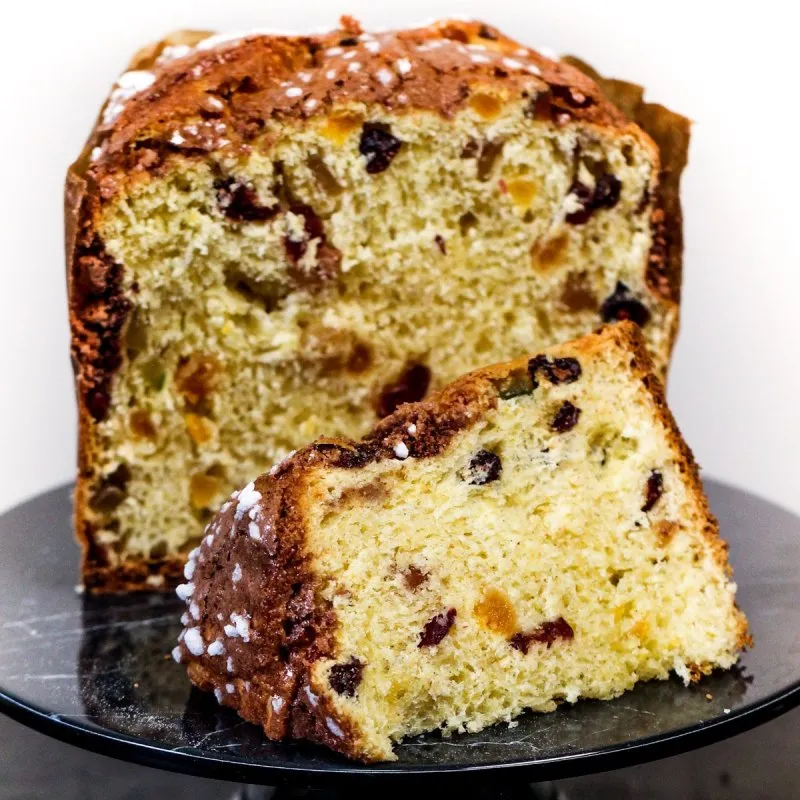
Traditional Panetone of Fruit with Natural Injument
Pre-preparallor: 13 hours horas15 minutes minutes
Preparing Time: 45 minutesminutos
Rest: 1 day day 10 hourshoras
Total: 2 daysdias
It yields: 2 units (?650g)
Adaptation of the yeast
- 30 g wild yeast (ferment style sourdough 100% hydration)
- 90 g wheat flour (split; normal flour)
- 45 g water (split; room temperature, 25-30oC)
The enriched wheat flour
- 477 g wheat flour (protein content 10%)
- 23 g gluten flour (protein content 75-80%)
Base mass
- 50 g adapted yeast
- 170 g water (ambient temperature, 25-30oC)
- 0,5 g instant dry organic yeast (less than 1-8 tsp)
- 70 g crystal sugar
- 50 g yolk (about 3 units with 16g/ever)
- 290 g wheat flour (the enriched made in this recipe)
- 70 g unsalted butter (ambient temperature, 25-30oC)
Final mass
- 140 g wheat flour (the enriched made in this recipe)
- 30 g yolk (about 2 units with 16g/ever)
- 5 g refined salt
- 2 g taiti lemon scrape (2 medium lemons)
- 10 g orange shaver (2 medium oranges any variety, used pear)
- 1 unidadevanilla beam (sharp; or 12mL extract)
- 46 g water (ambient temperature, 25-30oC)
- 70 g crystal sugar
- 110 g unsalted butter (ambient temperature, 25-30oC)
- 15 g honey (or corn syrup)
Fruit Filling
- 100 g crystallized fruit
- 50 g dried apricot (chopped)
- 50 g white grape-pass
- 50 g dark grape-pass
- 50 g dry cranberry
Crunchy coverage
- 80 g crystal sugar
- 30 g clear
- 5 g vegetable oil
- 5 g cornmeba
- 5 g cocoa powder
- 5 g almond flour
Decoration
- 40 g butter without salt (frozen, split; optional)
- 10 g perola sugar (optional)
Use the quantities inunits of measurements by weight and volumewhen you are present. The measures incups / harvestersare just onecourtesy of the systemand e e less precise. . .
1 cup: 250mL | 1 tablespoon: 15mL.
Adaptation of the yeast
- Mix wild yeast (30g), flour (30g) and water (15g) in a bowl.It will be a dense and almost dry dough, it is so.
- Leave semi-tamed (if you are to thread, do not thread) and book for 4 hours at room temperature (30-32oC). I suggest you start at 9 a.m. and 2 days before when you want to eat the panettone.
- Repeat the action every 4 hours. That is, at 1 p.m. he will separate 30g from this dense yeast that was fed at 9am, and add flour (30g) and water (15g) again, book for another 4 hours. The rest of the leaven that is left can be discarded.
- Then, at 5 p.m. will separate 30g from this dense yeast that was fed at 1 p.m., and re-add flour (30g) and water (15g), set aside for another 4 hours. The rest of the leaven that is left can be discarded.
The enriched wheat flour
- Mix the wheat flour with the gluten flour in a container with lid and well-covered.
- Shake the container by capping very well to distribute the gluten flour equally throughout the flour.
- This step is important to transform a common flour of 10% total proteins, for a flour with 13% total protein. This enriched flour will be used in the other stages. And yes, it is necessary. And no, you can’t replace it with a flour improver, I tested it.
Base mass
- Mix 50g of the adapted yeast (after having been fed 3 times every 4 hours), water, dry organic yeast, sugar, yolks, flour in a bowl and beat with the mixer hook the mixer for 2-3 minutes until uniform.
- Add the butter gradually until fully absorbed by the dough, keep tapping for 1 minute.
- Cover the bowl with plastic film and leave to ferment for 12 hours, yes 12 hours, at room temperature about 30-32oC.
Final mass
- Add to the base dough after 12 hours of fermentation: flour, lemon zest taiti, orange zest, zest of the inner part of vanilla, refined salt, yolks, agra.s (reserve 10g for the end) and beat with the batter hook of the mixer for 2-3 minutes until it is uniform.
- Add the sugar in 3 steps, waiting for it to be absorbed by the mass, beating low-medium speed (which your mixer endures that can be used for heavy dough).
- Put the butter down until it is fully absorbed by the dough at low speed, keep beating for 1 minute. You may need to shaving the sides of the bowl from time to time.
- Beat the dough at low-medium speed (which your mixer can stand that can be used for heavy mass) for about 5-6 minutes or until you start releasing from the sides of the bowl.
- Add the remaining water and honey, keep hitting at low speed.
- Add the candied and dried fruits of the filling continue to beat until everything is well uniform.
- Transfer the dough on a clean surface (it can be a handling board) to make the technique of bending over itself of the dough.
- With your left hand take the front of the dough, while the right hand takes the back of the dough. Lift slightly and rotate 90o with this the left side should go down the mass, and the direct side turns to the top of the mass. Thus, the part that was the front of the mass becomes the esqeurda side of it, and who was the back became the direct side. I redo the process a few times, 5-6 times. In the video it is easier to see the maneuver.
- Place in the bowl again, cover with plastic film or damp cloth. Let it ferment for 30 minutes at room temperature of 30-32oC.
- At 30 minutes of fermentation, do the technique of bending over yourself inside the bowl. Take a portion of the top of the dough, pull and put on itself taking to the bottom, as if doubling to 180 degrees. Turn the bowl at 90 degrees and repeat the process again until the circumference is completed.
- Let the dough ferment for another 30 minutes, do not forget to cover again with plastic film.
- Divide the mass into two 650g portions. When I separated, I tested with 550g (which was the amount I used in another recipe) and 600g, and yes had a small amount of mass. Particularly, I thought they might have gotten bigger in shape. So I suggest 650g.
- On a board or surface clean, leave each piece in the shape of a ball, the famous bulb on the dough. It can be folding the tips on yourself.
- And then form a ball with the dough to give a little traction, dragging the dough over the surface. It may be a little difficult because of the fat of the mass. Mine was pretty slippery.
- Place each slip-laced dough in the form of paper for panettone of 500g (10cm high by 13cm in diameter).
- Leave to ferment for 6-8 hours (yes, 6-8 hours) in a temperature of 30-32oC and if you have humidity, even better. It can be placed in the oven with the light accesses as well.
- The dough should ferment enough that it arrives close to the height of the side.
Crunchy coverage
- Mix crystal sugar, egg whites, oil, cornmeal, cocoa powder, almond flour in a bowl until it is very even.
- It will be used moments before the panetones go to the oven.
Panetone baking
- If everything went well, the panetones are already well grown between 7 hours of fermentation. Then, in the final 30 minutes to complete the 8 hours, preheat the oven to 180oC.
- Cut a “X” on the surface of the panettone with a shilet (that old blade) right in the center.
- If you want to put the butter in the center 20g of butter, or use the crunchy topping. If you use the topping, do not put the butter. I highly recommend coverage.
- Save the perolate sugar from above, if you wish.
- Ass for 50-45 minutes at 180oC or until golden. Ouy better, the internal temperature should pass 85oC
- Remove from the oven and shoot two barbecue sticks in parallel at the base of each panettone one on each side and leave suspended on the head until cool.
- After cold, remove the sticks.
- Store in container with lid.
- Adapted : How To Make Traditional Panettone At Home
- Wheat flour, 10% total protein: is the most common type of flour it has on the market. Technically, it can be any brand. I used Anaconda Premium.
- Gluten flour: there are basically two types, which I have seen. The difference is the gluten/protein content: it has 40% and 75%. For the recipe is necessary the version of 75%, it is sold in stores of natural products.
The recipe has links to affiliate program, if bought, PratoFundo can receive a commission on the sale that helps keep the site on the air.
Nutritional info is only courtesy of the system and generated automatically; they may not reflect the nutritional reality of the recipe.
KEYWORD: natural yeast, wild yeast, panettone, baking, Christmas recipes

Sign up for our newsletter and stay up to date with exclusive news
that can transform your routine!
Warning: Undefined array key "title" in /home/storelat/public_html/wp-content/plugins/link-whisper-premium/templates/frontend/related-posts.php on line 12
Warning: Undefined array key "title_tag" in /home/storelat/public_html/wp-content/plugins/link-whisper-premium/templates/frontend/related-posts.php on line 13

